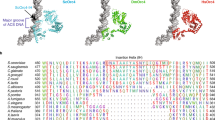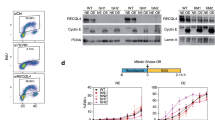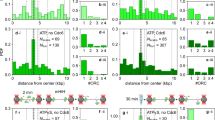Abstract
The initiation of DNA replication involves a minimum of four factors: a specific DNA sequence (origin), an initiator protein which binds to the origin, a helicase that unwinds the origin and a protein that binds single-stranded DNA that stabilizes the unwound origin1. In eukaryotic cells, the origin recognition complex2 (ORC) is the initiator protein and replication protein A (RPA; ref. 3) is the single-stranded DNA-binding protein. However, the helicase has not been identified and the nature of origins remains elusive, except in the case of Saccharomyces cerevisiae. A unique feature of eukaryotic DNA replication is that it occurs at a few-hundred discrete foci4. It has thus been proposed that a real origin must contain a specific DNA sequence and must be attached to replication foci. Using Xenopus laevis egg extracts, we have identified and purified a 170-kD protein, focus-forming activity 1 (FFA-1), which is required for the formation of replication foci5. Here we report that FFA-1 has DNA-helicase activity. Moreover, it is a homologue of the human Werner syndrome gene product WRN, a protein associated with premature ageing in humans6.
This is a preview of subscription content, access via your institution
Access options
Subscribe to this journal
Receive 12 print issues and online access
$209.00 per year
only $17.42 per issue
Buy this article
- Purchase on Springer Link
- Instant access to full article PDF
Prices may be subject to local taxes which are calculated during checkout






Similar content being viewed by others
Accession codes
References
Kornberg, A. & Baker, T. DNA Replication. (Freeman, New York, 1992).
Bell, S.P. & Stillman, B. ATP-dependent recognition of eukaryotic origins of DNA replication by a multiprotein complex. Nature 357, 128–134 (1992).
Wold, M.S. Replication protein A: a heterotrimeric, single-stranded DNA binding protein required for eukaryotic DNA metabolism. Annu. Rev. Biochem. 66, 61–92 (1997).
Newport, J. & Yan, H. Organization of DNA into foci during replication. Cur. Opin. Cell Biol. 8, 365 –368 (1997).
Yan, H. & Newport, J. FFA-1, a protein that promotes the formation of replication centers within nuclei. Science, 269 1883–1885 (1995).
Yu, C.E. et al. Positional cloning of the Werner's syndrome gene. Science 272, 258–262 (1996).
Adachi, Y. & Laemmli, U.K. Identification of nuclear pre-replication centers poised for DNA synthesis in Xenopus egg extracts: immunolocalization study of replication protein A. J. Cell Biol. 119, 1–15 (1992).
Yan, H. & Newport, J. An analysis of the regulation of DNA synthesis by cdk2, Cip1, and licensing factor. J. Cell Biol. 129, 1–15 (1995).
Stahl, H., Droge, P. & Kinppers, R. DNA helicase activity of SV40 large tumor antigen. EMBO J. 5, 1939–1944 (1986).
Imamura, O. et al. Cloning of a mouse homologue of the human Werner syndrome gene and assignment to 8A4 by fluorescence in situ hybridization. Genomics 41, 298–300 (1997).
Ellis, N.A. DNA helicases in inherited human disorders. Cur. Opin. Gen Dev. 7 , 354–363 (1997).
Gobalenya, A.E., Koonin, E.V., Donchenko, A.P. & Balinov, V.M. Two related superfamilies of putative helicases involved in replication, recombination, repair, and expression of DNA and RNA genomes. Nucleic Acids Res . 17, 4713–4730 ( 1989).
Puranam, K.L. & Blackshear, P.J. Cloning and characterization of RECQL, a potential human homologue of the Escherichia coli DNA helicase RecQ. J. Biol. Chem. 47, 29838– 29845 (1994).
Ellis, N.A. et al. The Bloom's syndrome gene product is homologous to RecQ helicases. Cell 83, 655–666 ( 1995).
Gangloff, S., McDonald, J.P., Bendixen, C., Arthur, L. & Rothstein, R. The yeast type I topoisomerase Top3 interacts with Sgs1, a DNA helicase homolog: a potential eukaryotic reverse gyrase. Mol. Cell. Biol. 14, 8391–8398 (1994).
Stewart, E., Chapman, C.R., Al-Khodairy, F., Carr, A.M. & Enoch, T. rqh1+, a fission yeast gene related to the Bloom's and Werner's syndrome genes, is required for reversible S phase arrest. EMBO J. 16, 2682–2692 ( 1997).
Mushegian, A.R., Bassett, D.E. J., Boguski, M.S., Bork, P. & Koonin, E.V. Positionally cloned human disease genes: patterns of evolutionary conservation and functional motifs. Proc. Natl Acad. Sci. USA 94, 5831– 5836 (1997).
Fukuchi, K., Martin, G.M. & Monnat, R.J. Mutator phenotype of Werner syndrome is characterized by extensive deletions. Proc. Natl Acad. Sci. USA 86 , 5893–5897 (1989).
Takeuchi, F. et al. Altered frequency of initiation sites of DNA replication in Werner's syndrome cells. Hum. Genet. 60, 365– 368 (1982).
Fujiwara, Y., Kano, Y., Ichihashi, M., Nakao, Y. & Matsumura, T. in Werner's Syndrome and Human Aging (eds Salk, D., Fujiwara, Y. & Martin, G. M.) 459–477 (Plenum, New York, 1985).
Fujiwara, Y., Higashikawa, T. & Tatsumi, M. A retarded rate of DNA replication and normal level of DNA repair in Werner's syndrome fibroblast cultures. J. Cell Physiol. 92, 365–374 (1977).
Yu, C.E. et al. Mutations in consensus helicase domain of the Werner syndrome gene. Am. J. Hum. Genet. 60, 330–341 (1997).
German, J. Bloom syndrome: a mendelian prototype of somatic mutational disease. Medicine 72, 393–406 (1993).
Wang, R., Kobayashi, R. & Bishop, J.M. Cellular adherence elicits ligand-independent activation of the Met cell-surface receptor. Proc. Natl Acad. Sci. USA 93, 8425–8430 (1996).
Yan, H., Merchant, M. & Tye, B.-K. Cell cycle-regulated nuclear localization of MCM2 and MCM3, which are required for the initiation of DNA synthesis at chromosomal replication origins in yeast. Genes Dev. 7, 2149– 2160 (1993).
Acknowledgements
This research was supported by a grant from the National Institute of Health to J.N. and a grant from the V Foundation to H.Y.
Author information
Authors and Affiliations
Corresponding author
Rights and permissions
About this article
Cite this article
Yan, H., Chen, CY., Kobayashi, R. et al. Replication focus-forming activity 1 and the Werner syndrome gene product . Nat Genet 19, 375–378 (1998). https://doi.org/10.1038/1263
Received:
Accepted:
Issue Date:
DOI: https://doi.org/10.1038/1263
This article is cited by
-
RecQ helicases: guardian angels of the DNA replication fork
Chromosoma (2008)
-
Essential role of limiting telomeres in the pathogenesis of Werner syndrome
Nature Genetics (2004)



